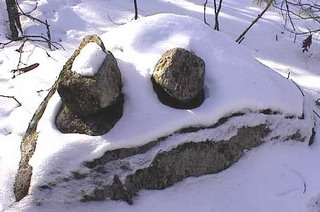
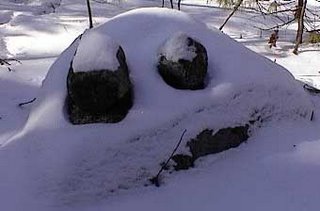
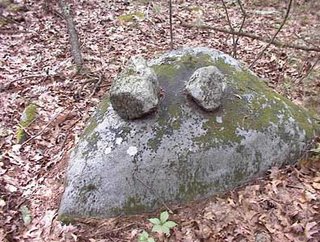
This is about rock piles and stone mound sites in New England. A balance is needed between keeping them secret and making them public. Also arrowheads, stone tools and other surface archaeology.
 I tried to clean this up and kept finding more rocks until I had uncovered something 8 feet across. In this next photo, the "head" is above and right of center. But note the two extreme left and right rocks: each at the tip of a protrusion of rocks from the main "body".
I tried to clean this up and kept finding more rocks until I had uncovered something 8 feet across. In this next photo, the "head" is above and right of center. But note the two extreme left and right rocks: each at the tip of a protrusion of rocks from the main "body". thought I saw a figure in this, what do you think? One feature that does not come through in the photo is a vertical flake of rock, a wee bit left of center in the photo. I wondered if this might represent a phallus. It is in approximately the correct position with respect to the head; but I couldn't make a good case for their being balls. I try to sketch the thing:
thought I saw a figure in this, what do you think? One feature that does not come through in the photo is a vertical flake of rock, a wee bit left of center in the photo. I wondered if this might represent a phallus. It is in approximately the correct position with respect to the head; but I couldn't make a good case for their being balls. I try to sketch the thing: Don't know if anything is to be made of this. Several other rock piles are placed like this one: on the southeastern edge of a vernal pond. The most interesting thing about this pile was that, as I dug it out, I found a solid layer of charcoal on top of the pile and underneath the duff. I saved some in case a carbon dating opportunity presents itself. So this suggest that sometimes a fire would be lit on top of a rock pile.
Don't know if anything is to be made of this. Several other rock piles are placed like this one: on the southeastern edge of a vernal pond. The most interesting thing about this pile was that, as I dug it out, I found a solid layer of charcoal on top of the pile and underneath the duff. I saved some in case a carbon dating opportunity presents itself. So this suggest that sometimes a fire would be lit on top of a rock pile. It looked a bit like this and had a vertical flake.
It looked a bit like this and had a vertical flake.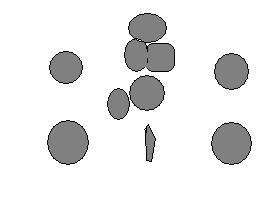 Re-reading the text above about the robot warrior and its vertical flake, it is surprising I did not notice the same structure in this other pile.
Re-reading the text above about the robot warrior and its vertical flake, it is surprising I did not notice the same structure in this other pile.
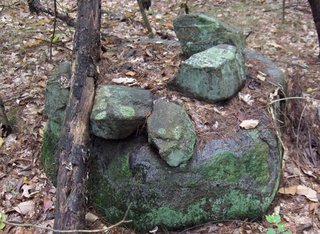 Interestingly this faces uphill, to the north towards the elongated pile mentioned here. and to the bald spot I will describe later.
Interestingly this faces uphill, to the north towards the elongated pile mentioned here. and to the bald spot I will describe later. "Another Indian sign was a little heap of stones, meaning "We camped here because one of us was sick." This originated in the hot stones used for making steam in the vapor bath that is so much favored by the Indian doctors."
"Another Indian sign was a little heap of stones, meaning "We camped here because one of us was sick." This originated in the hot stones used for making steam in the vapor bath that is so much favored by the Indian doctors." I have toyed with the idea that the upper rock in a rock-on-rock structure could be deliberately shaped and representative. This weekend, while wandering around between Brown Rd and Jacob Gates Lane in Harvard, I started noticing one after another example of rock-on-rock structures with a kind of off-center "Manitou stone" shape - as shown above. Unfortunately, I was camera challenged and came away with only one decent picture for my efforts. Please imagine lots of other examples (six or eight) that used this same shape. I called the shape a "boat rudder" in my little book, where I constructed a fanciful argument as to why it might represent a heart.
I have toyed with the idea that the upper rock in a rock-on-rock structure could be deliberately shaped and representative. This weekend, while wandering around between Brown Rd and Jacob Gates Lane in Harvard, I started noticing one after another example of rock-on-rock structures with a kind of off-center "Manitou stone" shape - as shown above. Unfortunately, I was camera challenged and came away with only one decent picture for my efforts. Please imagine lots of other examples (six or eight) that used this same shape. I called the shape a "boat rudder" in my little book, where I constructed a fanciful argument as to why it might represent a heart.  This looks like a bird. Maybe the off-center Manitou stones shape represents a bird too.
This looks like a bird. Maybe the off-center Manitou stones shape represents a bird too. I was walking (tresspassing actually) in the middle of the woods, on the border between Sterling and Leominster, Mass. and had just come from a small ceremonial rock pile site on a slope facing west over a wetland. The slope was along a ridge and as I got to the northern end of the ridge I turned right to climb to the top of the ridge and see what was there. I found something new to me: a human figure carved with an axe from a tree stump and facing northward over a wetland and towards further hills to the north.
I was walking (tresspassing actually) in the middle of the woods, on the border between Sterling and Leominster, Mass. and had just come from a small ceremonial rock pile site on a slope facing west over a wetland. The slope was along a ridge and as I got to the northern end of the ridge I turned right to climb to the top of the ridge and see what was there. I found something new to me: a human figure carved with an axe from a tree stump and facing northward over a wetland and towards further hills to the north.
 There was a rusty can next to the figure and it looked to me like an old kerosene can (can anyone identify it?). In the above picture you can get a closer look. Notice the can top has been punctured in two places. I am pretty sure the punctures were made with an axe. If this is indeed a punctured kerosene can, then there must have been some fire making activity at this spot - but I did not see any charcoal.
There was a rusty can next to the figure and it looked to me like an old kerosene can (can anyone identify it?). In the above picture you can get a closer look. Notice the can top has been punctured in two places. I am pretty sure the punctures were made with an axe. If this is indeed a punctured kerosene can, then there must have been some fire making activity at this spot - but I did not see any charcoal.  What really struck me was the quality of the work. In this previous picture, from the back, note how the small of the back is hollowed out and the upper part of the buttocks are indicated. This is not the kind of detail a first time wood carver would do. Nor would an in-experienced person be able to carve such a simple but effective face, using an axe.
What really struck me was the quality of the work. In this previous picture, from the back, note how the small of the back is hollowed out and the upper part of the buttocks are indicated. This is not the kind of detail a first time wood carver would do. Nor would an in-experienced person be able to carve such a simple but effective face, using an axe. I have done some figure carving and it is not easy to do, especially not with an axe. This figure is the work of someone who knew how to use an axe and someone comfortable out in the woods. I do not think it is "new age" and, since this blog is a story about hidden activities of the Native Americans, I am only too happy to assume the figure is a ceremonial item, like the site nearby. This figure did remind me of the wooden effigies mentiond in Manitou on page 341.
I have done some figure carving and it is not easy to do, especially not with an axe. This figure is the work of someone who knew how to use an axe and someone comfortable out in the woods. I do not think it is "new age" and, since this blog is a story about hidden activities of the Native Americans, I am only too happy to assume the figure is a ceremonial item, like the site nearby. This figure did remind me of the wooden effigies mentiond in Manitou on page 341.Excerpts from MARTHA'S VINEYARD by Henry Franklin Norton. Copyright 1923
- "Hiacoomes came forward and shook the hand of his beloved teacher, and, bursting into tears, placed a white stone at his feet, saying: I put this stone here in your name and whenever I pass, here I shall place a stone in your memory until you return."
- "This monument was a boulder given by the Indians of Gay Head. The Martha's Vineyard Chapter, D. A. R., had a bronze tablet placed on the boulder telling the story of young Mayhew's work and death. Since the dedication in 1901 the greater part of the original pile of stones has been removed by souvenir hunters."
[Click here] to read the entire text. Scroll down about 1/3 for The Place on the Wayside.
 And here is the circular ditch. Can you make this out on the forest floor in the dappled light?
And here is the circular ditch. Can you make this out on the forest floor in the dappled light? The rock pile is just to the right of this.
The rock pile is just to the right of this.
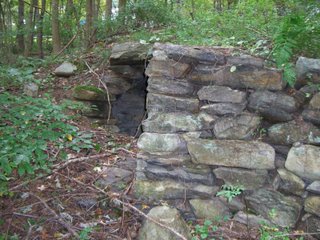
 Note the semicircle of rock on the left.
Note the semicircle of rock on the left.
 I associate such structures with effigies where, the elongated rock is supposed to be a pedestal for the figure. That may not be valid here but many of the piles on this slope have the feature.
I associate such structures with effigies where, the elongated rock is supposed to be a pedestal for the figure. That may not be valid here but many of the piles on this slope have the feature.  and another:
and another: